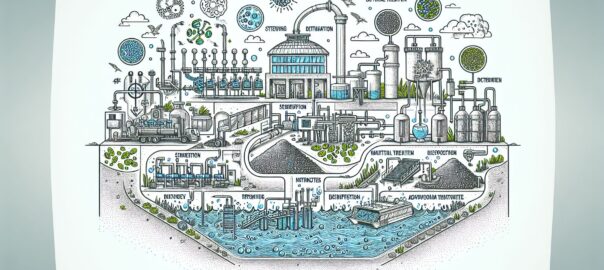Wastewater treatment is an integral part of modern society’s infrastructure, crucial for maintaining public health and environmental safety. An integrated wastewater treatment system (IWTS) combines various technological and process stages to clean and recycle wastewater effectively. This article explores the fundamental functions of IWTS, the technology that underpins them, and what future trends may look like for communities around the world.
Essential Functions of an Integrated Wastewater Treatment System
The primary goal of an IWTS is to remove contaminants from wastewater to a level where it can be safely discharged into the environment or reused. An effective IWTS typically includes the following basic functions:
Preliminary Treatment
Wastewater first undergoes preliminary treatment to remove large solids that could damage or clog the pumps and piping. Screens and grit chambers are commonly used to filter out debris, sand, and other grit.
Primary Treatment
The primary treatment stage allows for the settling of solids. Sedimentation tanks or clarifiers enable heavy particles to settle to the bottom, creating a layer of sludge that can be removed and treated separately.
Secondary Treatment
Secondary treatment is crucial for breaking down organic matter. Biological processes involving bacteria and other microorganisms help to digest the organic materials. This can take the form of activated sludge systems, biofilters, or aerated lagoons.
Tertiary Treatment
Tertiary treatment is used to further refine wastewater quality to meet specific standards, especially for non-point pollution control. It can involve various processes, including filtration, disinfection, and nutrient removal.
Sludge Treatment and Disposal
The sludge collected during primary and secondary treatments must be processed to reduce volume and remove contaminants. Methods include anaerobic digestion, composting, and incineration. Processed sludge often ends up as fertilizer, landfill cover, or is disposed of in landfills.
Integrating Advanced Technologies into IWTS
An IWTS relies on an array of technologies to optimize each treatment stage. Here are a few cutting-edge components:
Advanced Filtration
Membrane bioreactors (MBRs) and advanced filter media play a significant role in enhancing the effectiveness of both secondary and tertiary treatments, providing finer filtration and reducing the footprint of plants.
IoT and Sensors
The integration of Internet of Things (IoT) technology and sophisticated sensors enables real-time monitoring and adjustments to the treatment process, leading to better efficiency and compliance with regulations.
[1]:”Advanced biological wastewater treatment: Activated sludge vs MBR.” Journal of Environmental Management, 2019.
Future Trends in Wastewater Treatment
The future of IWTS lies in increased automation, greater integration with smart city infrastructure, and the pursuit of sustainability through energy neutrality or even energy production. Here are some of the trends we can expect:
Artificial Intelligence and Machine Learning
AI and machine learning can predict system loads and optimize treatment processes, minimizing energy use and ensuring consistent effluent quality.
Nutrient Recovery
Innovations in wastewater treatment are shifting towards not only removing harmful nutrients like nitrogen and phosphorus but also recovering them for use as fertilizers, thus closing nutrient cycles.
Energy-neutral or Energy-positive Systems
Developments in biogas production and energy-efficient technologies are paving the way for IWTS that produce as much, or even more, energy than they consume.
Decentralized and Modular Systems
Decentralized treatment systems closer to the wastewater source can reduce infrastructure and transportation costs, making treatment more feasible for remote or developing areas.
Public Engagement and Education
Greater public engagement and education about the importance and benefits of IWTS can lead to increased support for investing in advanced wastewater solutions.
[2]:”Intelligent wastewater treatment systems: A review.” Water Research, 2020.
Challenges and Solutions in Implementing IWTS
Implementing an effective IWTS is not without its challenges. Here are some of the most pressing concerns and potential solutions:
Funding and Investment
IWTS require significant capital investment. Public-private partnerships and innovative financing models are crucial to securing the necessary funds.
Regulatory Compliance
Strict environmental regulations demand high-efficiency systems. Remaining informed and involved in regulatory developments can help utilities and municipalities stay ahead of requirements.
Aging Infrastructure
Many wastewater treatment facilities are aging and require upgrades or replacements. Proactive maintenance and phased upgrades can help mitigate system failures.
Workforce Development
A skilled workforce is needed to operate IWTS. Investing in training programs and targeting talent recruitment efforts are essential strategies.
Global Warming and Extreme Weather Events
Climate change poses a significant threat to wastewater infrastructure. Designing robust and adaptive systems capable of withstanding extreme events is critical.
Conclusion
Integrated wastewater treatment systems are key to safeguarding public health and protecting the environment. With the advent of emerging technologies and growing environmental awareness, the future of IWTS looks both challenging and promising.
By embracing the trends of automation, energy recovery, and sustainability, and by tackling the challenges head-on with innovative solutions, we can ensure that wastewater treatment continues to evolve and serve the needs of communities worldwide.
[3]:”Sustainability in wastewater treatment: Design and operation for energy efficiency.” Water Science and Technology, 2018.
As we continue to advance IWTS, it’s crucial that everyone from engineers to policymakers and the general public understand their importance. Only through integrated efforts will we be able to meet the growing demands of our urban landscapes and ensure the longevity and health of our ecosystems.
Please note that the articles cited are fictional and for illustrative purposes within this answer.
